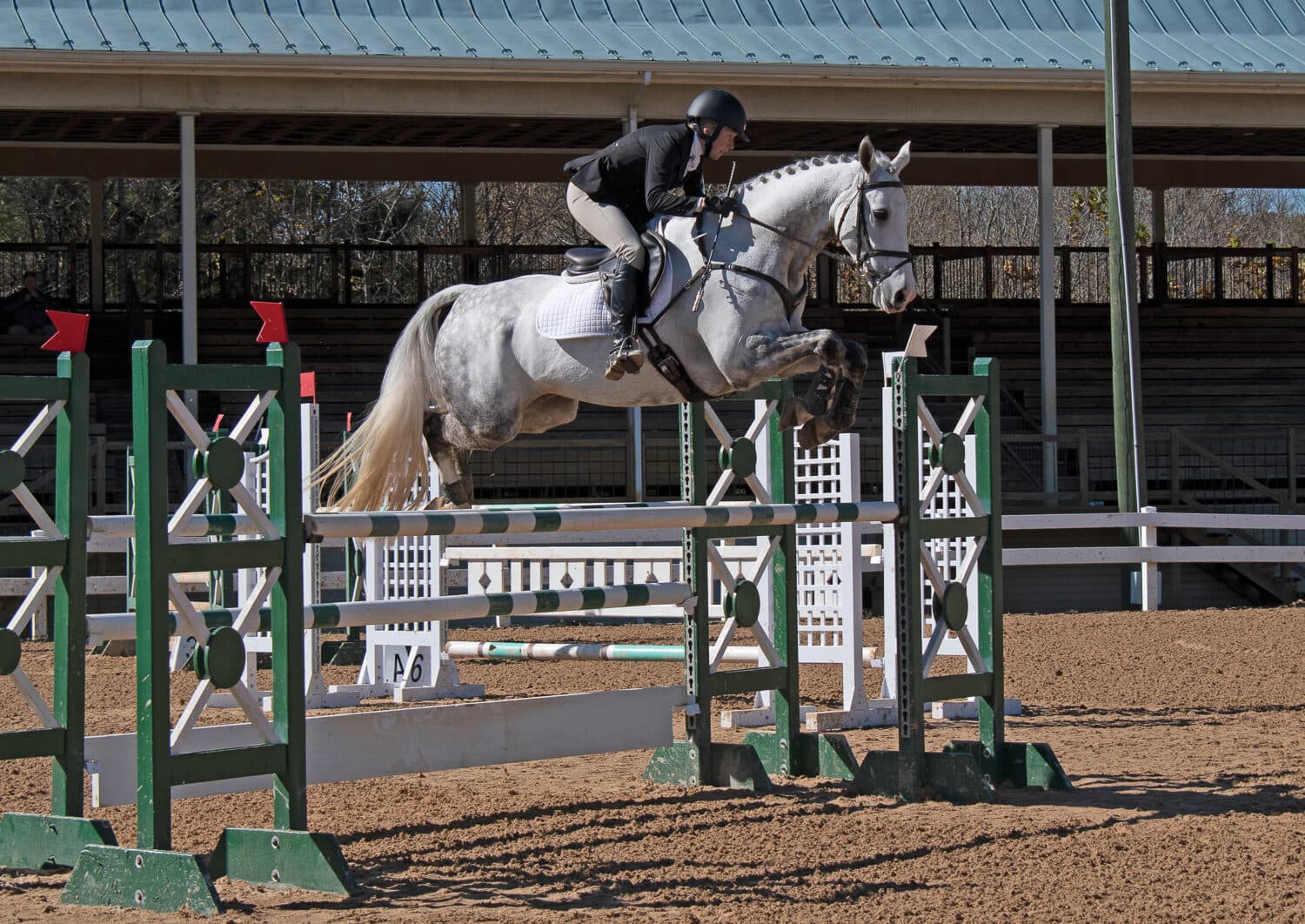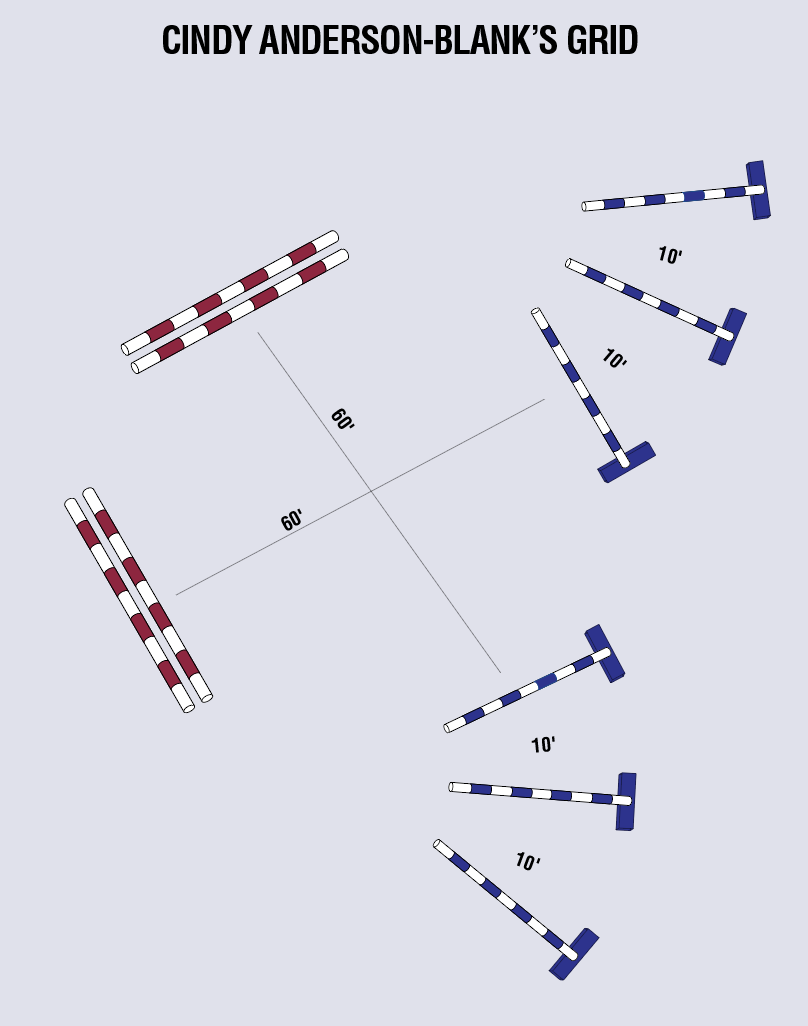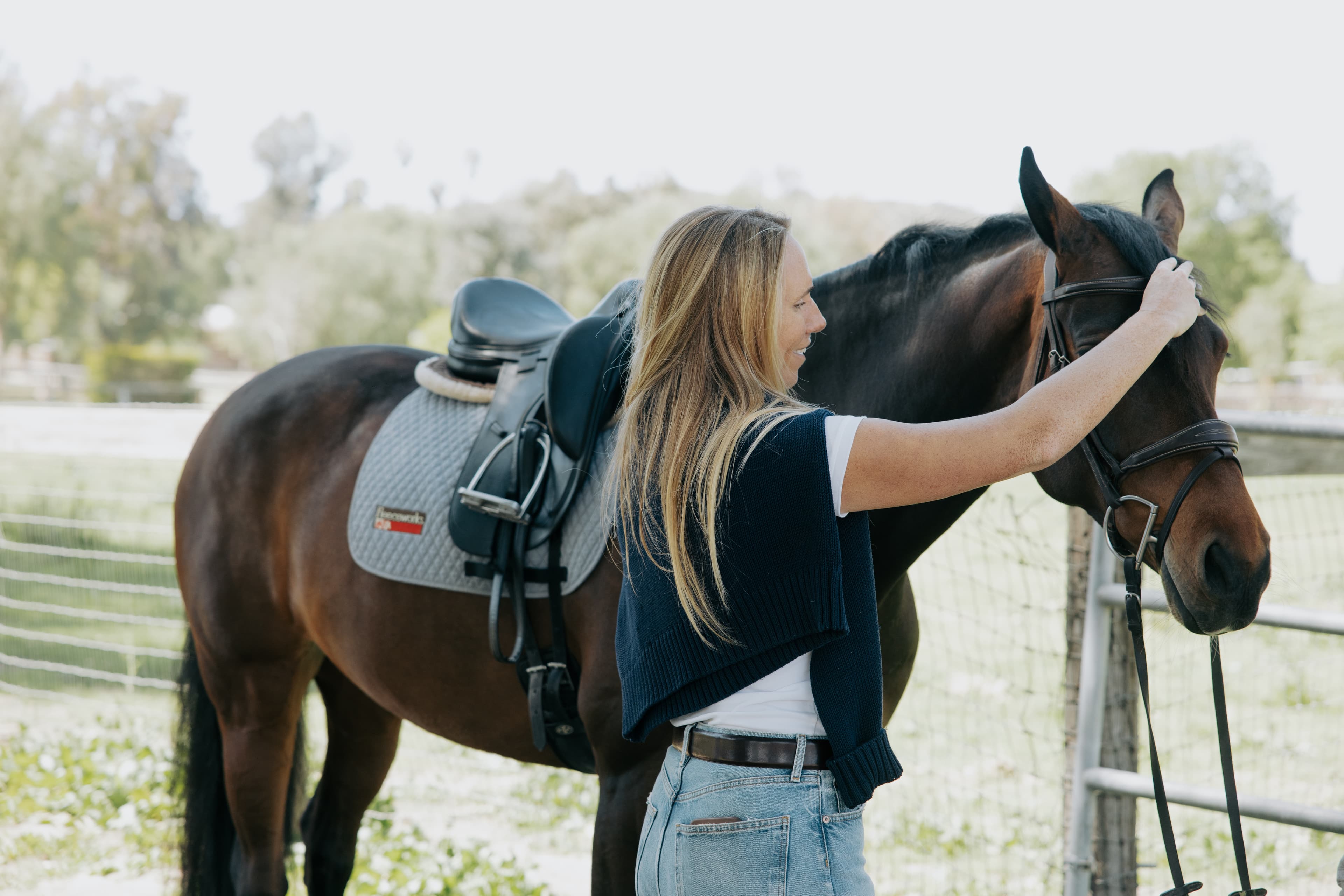Grid Pro Quo with Cindy Anderson-Blank

Ready to spice up your arena routine this winter training season? In this series, we are revisiting some of our favorite Grid Pro Quo articles from Eventing USA to help you use the off-season to your advantage and keep you and your horse in tip-top shape for when it's time to get back out there. Click here to check out other past Grid Pro Quo exercises!
WHY:
There are so many great exercises out there and so many great trainers to learn from, and oftentimes my exercises are hybrids of others that I have learned from either watching a lesson or taking a lesson myself. However simple, I have found this particular exercise to be extremely versatile and beneficial for horses and riders of all levels.
A common theme you should find in all jumping lessons and exercises, regardless of your level, is a huge emphasis on the quality of the canter and connection. I have found that this concept can be quite difficult to learn, and even more difficult to teach. I sat down to try to come up with an exercise that would make this concept a little easier to teach, and learn, and came up with this simple pattern.
The three raised bounce cavaletti on a curve help to illustrate to the rider the feel of the “jump” to the canter – or the active tempo, engagement, and ‘withers up’ feel – that is essential to the quality of your jumping canter. By then relating the distance from the cavaletti to the oxer, it allows the rider to take this feel of activity and balance forward to a jump.
This is a great set up for someone who doesn’t always have a jump crew available to them, as you can do the exercise in pieces without needing to change the fence height too often. But you still have plenty of footwork to do to keep it fun while also giving your horse a good workout.
I like to set a 60-foot distance from the last cavaletti to the oxer, with the intention of it being ridden in five strides. This usually rides quite comfortably for an average horse because you are coming from a cavaletti, not a jump. I like the five-stride distance because I find that is enough distance that the rider has to work to maintain the steady, active stride. But also, there is plenty of room that if you run into problems at the cavaletti you can safely circle out of the line without pulling your horse’s focus from the oxer.
The distance should be comfortable and doable for the horse, as in this exercise I am more focused on teaching an active steady stride than challenging the collection or reach of the stride. So minor adjustment can, and should, be made for a very short-strided horse or a tall, gangly youngster.
HOW:

To start this exercise I place all the cavaletti and jump poles on the ground, and simply canter through so that the horse and rider can develop a connection from the leg to rein which will allow them to find a distance to the first pole as well as negotiate the curve of the exercise. I often start just inside the middle of the poles on a waiting stride, focusing on accuracy and not allowing the horse to drift out or in on the curve.
If you have a less experienced horse or rider, you can either start by trotting through the cavaletti or you can try removing one or two poles and start by just cantering over a pole on a curve. I will want to gradually add in the other poles until the horse and rider are comfortably cantering through all three.
From here I will move on to cantering each one of the oxers on a figure eight, being sure to start with a comfortable warm-up height for the horse and rider, which can range from poles on the ground for my lower level pairs or a simple 2’6” square oxer for my more experienced pairs. My focus is on a steady pace and having your horse move off your inside leg on landing to set them up for the flying change or a simple change, depending on the level of the pair. Your horse moving laterally off your leg is very important because as the exercise builds, being able to quickly recover the canter on landing will enable you to continue on your figure eight pattern. If you or your horse are struggling with this, simply add a small circle on the landing side of the oxer so you can focus on reestablishing the inside leg to outside rein connection.
Once my horses are easily working through the two elements separately, it’s time to put them together! I will start by raising the outside end of all of the cavaletti. How high you raise it will depend on the level of your horse and what you’re hoping to accomplish, which can vary from horse to horse. A very careful horse that tends to jump the cavaletti may only need the cavaletti raised a few inches to add plenty of activity to the canter. Whereas a complacent horse that would rather step on the cavaletti may need it a few inches higher for them to make a good effort. If you’re lucky you will have cavaletti blocks with several settings to allow you to pick just the right height for your horse. If you don’t have cavaletti blocks, you can always use a jump standard with the cup set low. The intention is to both raise the pole, while also not allowing it to roll too easily.
Even though you have already allowed your horse to canter through the cavaletti on the ground and established holding the line through them, when you raise them up, it is common for the horse to want to drift one way or the other. If you’re still struggling with drifting after a few run throughs, try alternating which end of the cavaletti you raise to help you keep your horse in the middle of the exercise.
As a rider, the challenge is to try to maintain the active, balanced stride created by the cavaletti in the five strides to the oxer. And then don’t forget to keep riding on the landing side of the oxer by concentrating on moving your horse off your inside leg as you keep looking for your next set of cavaletti. By repeating this figure-eight exercise a few times continuously, the rider can practice getting the feel of their active canter as well as landing and recovering immediately without having to take a break. And even though you only have two jumps here, this is a great exercise for practicing your course riding.
Once the horse and rider are performing this well, it’s time to make it more challenging! To do this, simply reverse the exercise so that you are jumping your oxer to your cavaletti, instead of vice versa. The focus is now intensified as you need to land in a canter with a stride length and balance that allows you to work through the cavaletti easily.
At any time during the exercise, regardless of your level, you can add in walk transitions as a way to balance your horse, with the idea being that they learn to develop on their own a canter that effectively negotiates the cavaletti and oxer. Unlike some traditional gymnastic exercises, this one requires more influence from the rider. It is meant to help not only improve the horse’s canter, but help teach the rider feel. It’s also a great exercise to check on yourself, as the distances will quickly tell you whether your stride and tempo was what you thought it was before you approached the first cavaletti.
While not necessary, you can raise the oxer as appropriate for your horse. If a horse is quite confident, it can be a good way to introduce a bigger fence because the static distance is predictable for both horse and rider. You can also increase difficulty by choosing to go more to the inside or outside of the cavaletti to play with opening and compressing your stride while on course.
About Cindy Anderson-Blank
A lifelong horsewoman, Cindy Anderson-Blank has been based at Phyllis Dawson’s Windchase in the heart of Area II since 2011. From starting babies to competing at the four-star level, she has an impressive skill set with careful focus always placed on the partnership between horse and rider. Known for her dedication and perseverance, Anderson-Blank enjoys working with horses and riders of all levels, from those just starting out in the sport to more experienced competitors. To learn more about Anderson-Blank, visit www.teamwindchase.com.














